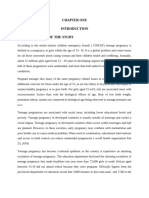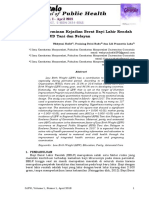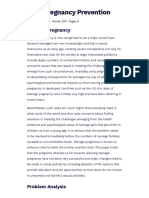162 324 1 SM
162 324 1 SM
Uploaded by
Mor OB-GYNCopyright:
Available Formats
162 324 1 SM
162 324 1 SM
Uploaded by
Mor OB-GYNOriginal Description:
Original Title
Copyright
Available Formats
Share this document
Did you find this document useful?
Is this content inappropriate?
Copyright:
Available Formats
162 324 1 SM
162 324 1 SM
Uploaded by
Mor OB-GYNCopyright:
Available Formats
1st International Respati Health Conference (IRHC) [Juli 2019]
FACTORS OF LOW WEIGHT BABIES INCIDENCE ON TEENAGE
PREGNANCY: A SYSTEMATIC LITERATURE REVIEW
Rabiatunnisa1, Herlin Fitriani Kurniati2, Anjarwati3
Student of Midwifery, ‘Asyiyah University of Yogyakarta
Lecturer of ‘Aisyiyah University of Yogyakarta
*corresponding author: nisarabia93@gmail.com
Abstract.
Teenage pregnancy is a global problem in countries with high, medium and low income. In the
worldwide, teenage pregnancy is more likely to occur in peripheral communities. It is due to poverty,
lack of knowledge and education, and no job opportunities. Marriage at a young age often results in
young childbirth. Childbirth in adolescence (before the age of 20 years) is associated with a number
of complications, infant mortality, and low birth weight. This situation is due to immaturity of the
reproductive organs of adolescents for pregnancy so that it can adversely affect maternal health and
fetal development and growth.. The aim of this study was to find out the factors associated with the
incidence of low birth weight babies in teenage pregnancies.
1. INTRODUCTION
Teenage pregnancy become a global problem that high-income country, medium, or low. Each
year, approximately 21 million adolescents aged 15 to 19 years and 2 million adolescents under 15
years old to get pregnant. About 16 million adolescents aged 15 to 19 years and 2.5 million
adolescents under 16 years of giving birth. Although the number of births to teens has decreased
from 65 births per 1,000 women in 1990 to 47 births per 1,000 women in 2015, considering the
adolescent population globally increasing estimated pregnancy rate among adolescents will
continue to increase in 2030 (World Health Organization (WHO), 2017).
Teen pregnancy to be one contributor to maternal mortality rate (MMR) and infant mortality
rate (MMR). Adolescents younger than 20 years in a state of pregnancy until delivery is more at
risk of complications than women over the age of 20 years. Giving birth at an early age will have a
negative impact on the condition of babies born, one of the risks in the newborn is Infant Low Birth
Weight (LBW). This situation is due to the immaturity of adolescents to reproductive organs that
can harm pregnant mother's health as well as the development and growth of the fetus. According to
WHO (2017), the global infant mortality rate (IMR) is 19 per 1,000 live births, one of the
contributors AKB was lbw. Long-term impact on LBW that the baby will have developmental
disabilities such as sensory impairment (deaf blind), cerebral dysfunction (inability to speak,
learning, hyperactivity, behavioral disorders), eye damage, chronic lung disease and less growth. In
addition to young maternal age, there are other factors that lead to low birth weight in teenage
pregnancy, such as lack of knowledge, nutrition during pregnancy, environmental and social
support for pregnant teenagers obtained can affect the growth of the fetus. Marriage at a young age
often leads to delivery a young age.
Giving birth during adolescence (before age 20) is associated with a number of complications
and infant mortality and low birth weight. The basis is like maternal age, body mass index,
nulliparity and smoking habits. The influence of the family are also important, in addition to the
support material also emotional support (Harville, 2014). WHO defines low birth weight as a birth
FACTORS OF LOW WEIGHT BABIES INCIDENCE ON TEENAGE PREGNANCY: A SYSTEMATIC 849
LITERATURE REVIEW
1st International Respati Health Conference (IRHC) [Juli 2019]
weight less than 2500 grams and is a determinant of morbidity and mortality of fetal, neonatal,
cognitive impairment and increased risk of chronic non-communicable diseases adult future
(Belfort, et al 2018).
Results of research conducted by Minjares, et al (2016), suggests that the incidence of low
birth weight as a result of teenage pregnancies associated with maternal nutritional status as before
pregnancy and during pregnancy progresses, as well as the mother's weight gain during pregnancy.
On the condition of pregnancy, the nutritional needs of adolescents increased for fetal growth and
development, adolescent weight status before pregnancy tend to have an impact on birth weight
babies than weight status of adults in general. the characteristics of the neighborhood affect teen
pregnancy. Pregnant teens who live in low- income neighborhood would be more at risk of having a
baby with low birth weight.
Another study conducted by Karabulut, et al (2013), that an adequate prenatal care in
pregnant teen is not associated with increased adverse outcomes, except for low birth weight. In
addition to increasing the risk of having a child with low birth weight, teenage pregnancy also lead
to preterm birth, even severe neonatal conditions and increase the risk of neonatal death
(Ganchimeg et al, 2014).
2. MATERIALS AND METHODS
Identification of problems
Giving birth during adolescence (before age 20) is associated with a number of
complications and infant mortality and low birth weight. The basis is like maternal age, body mass
index, nulliparity and smoking habits. The influence of the family are also important, in addition to
the support material also emotional support.
Research Questions Based on Priority Issues
Any factors that cause low birth weight infants incident on teenage pregnancy?
Identification of Relevant Studies
On Systematic Literarure This review has been to identify literature with the development
of the framework as a basis to determine the inclusion and exclusion criteria so that the data sought
is not widened and focused on the context of the search. Then arrange Keyword designed and
focused on the framework by using the link "AND" and "OR". The keywords used are (
"Adolescent pregnancy" OR "Teen Pregnancy" OR "Teen mother" OR "Teenage parents" OR
"Adolescent mothers" OR "Young mothers") AND ( "Low birthweight" OR "Birth low" OR "Birth
weight "OR" Very low birthweight "). Incorporating these keywords into a search engine on the
database PubMed and Science Direct. On the database PubMed and Science Direct also organize
screening in these pages as filtering Full Text, Publish Data in 10 years ago, Human, and English.
Listing a number of articles and findings discussed in the screening process Prism Flow Diagram.
FACTORS OF LOW WEIGHT BABIES INCIDENCE ON TEENAGE PREGNANCY: A SYSTEMATIC 850
LITERATURE REVIEW
1st International Respati Health Conference (IRHC) [Juli 2019]
3. RESULTS AND DISCUSSION
Characteristics articles and thematic analysis
The findings obtained by systematic searches of articles published in 2008-2018, the author
and the source of the data obtained came from the United States (n = 3), Japan (n = 1), Brazil (n =
3) and Mexico (n = 1). Factors that influence the occurrence of low birth weight in teenage
pregnancy Social environment Journal entitled "Determinants of low birth weight in the children of
adolescent mothers: a hierarchical analysis". The results showed that the prevalence of low birth
weight by 10% with the different indicators in each region of Brazil, a survey carried out among
pregnant women younger than 20 years, researchers found that the birth rate of LBW associated
with the social environment of mother and unequal access to health services. The lack of hospital
resources for medical care, contribute to lower birth weights less developed areas compared to areas
further with the quality of prenatal care is better to reduce infant mortality and low birth weight.
FACTORS OF LOW WEIGHT BABIES INCIDENCE ON TEENAGE PREGNANCY: A SYSTEMATIC 851
LITERATURE REVIEW
1st International Respati Health Conference (IRHC) [Juli 2019]
Unfavorable social environment influence fetal growth during pregnancy and also the psychology
of adolescent mothers. Aspects of the social environment can affect pregnancy in the form of
family support, the exposure to pollution, poor education, youth lifestyle (smoking and alcohol
consumption) as well as access to health services. this corresponds to an intensive search conducted
Harville, et al (2014), that of teenage mothers who get good support from parents will form a
positive mindset in young and good health behavior during pregnancy to prevent the birth of babies
with low birth weight.
Pregnancy Care
Journal entitled "Risk Neighborhood Does Explain Disparities in Racial Disparities in Low
Birth Weight among Infants Born to Adolescent Mothers?"The results of this study indicate that the
birth was significantly different between the two groups of African-American race is black with
white race (P <0.01). The majority of teenage mothers aged less than 17 years old with a history of
pregnancy more than 1 time of the African-American race blacks tend to be at higher risk of having
a baby with low birth weight than white teen mothers. In addition to the races, inadequate prenatal
care in the black teenager's mother is also a trigger LBW births.
Journal entitled "Maternal and Perinatal Outcomes Among Adolescents and Mature
Women: A Hospital-Based Study in the North of Mexico" This study indicates that inadequate
prenatal care increases the likelihood of infants born LBW (OR = 2.02, 95% CI 1.22 to 1.35, P =
<0.01). LBW frequency as much as 5.6% of teenage mothers aged less than 16 years, 7.3% of
teenage mothers aged 16-19 years and 7.8% at age 20-34 years. Based on the results of bivariate
and multivariate statistical tests birth weight differences between groups of adolescent mothers
aged 16-19 years with mothers aged 20-34 years are not much different and become significant
after adjusting for the potential confounders (P = 0.02).
Every expectant mother needs care during pregnancy (antenatal care), in addition to
monitor fetal growth as well as early detection of complications during pregnancy. When a woman
is pregnant does not get adequate prenatal care it will be at higher risk of complications of labor to
give birth to babies with low birth weight (Vieira et al 2012). Prenatal care applies to mothers of all
ages, not only in adolescents aged less than 20 years. Pregnant women older than 20 years are also
at risk of having a baby with low birth weight if it does not receive adequate prenatal care.
Economic status
Journal entitled "Prematurity and Low Birth Weight among Brazilian Adolescents and
Young Adults" Research shows that most respondents low socio-economic status and living
outskirt of the city. The majority of teenage mothers are not married and did not complete his
education. Significantly mostly teenage mothers experiencing unwanted pregnancy, no or late
prenatal care prenatal care, as well as more teenagers use tobacco and alcohol during pregnancy
than women. Teenage mothers under the age of 16 years (9.7%) are more at risk of having a baby
of low birth weight compared to pregnant women aged over 20 years (3.5%) (P= 0.012).
Economic conditions that are less in adolescents associated with adequate nutrition during
pregnancy. The nutritional requirements and nutritious food during pregnancy to support fetal
growth and development. Insufficient nutritional intake on adolescent pregnancy increases the risk
of babies born with low birth weight. In addition to the nutritional needs, socio-economic status
also influence adolescents to regular prenatal care (Rocha, et al 2010). The results of this study
agree with that done by Mambo, et al (2016) that the condition of the poor economy, more
experienced by teenage mothers than women over the age of 20 years so hampered in prenatal care.
This condition will also increase the risk of adverse pregnancy.
FACTORS OF LOW WEIGHT BABIES INCIDENCE ON TEENAGE PREGNANCY: A SYSTEMATIC 852
LITERATURE REVIEW
1st International Respati Health Conference (IRHC) [Juli 2019]
Family support
Journal entitled "Parent-child Relationships, Parental Attitudes towards Sex, and Birth
Outcomes among Adolescents" The results of this study showed that women who become pregnant
adolescents at an early age and get support from parents is less likely to give birth to low birth
weight babies. White teens are more likely to get support from parents, direct relationships between
parents and children can control the behavior of smoking during kemamilan in adolescents.
Social support is needed by women during pregnancy in general, including adolescent
health and well-being. In addition to the support of parents, the husband was also instrumental in
providing support. It is associated with increased stress and depression during pregnancy that led to
the birth of a baby with low birth weight. Teens who have the support of the pair will reduce the
level of depression during pregnancy and more frequent antenatal regularly compared to teens who
do not get support or not having a partner. Most teens who have a partner, feel ready to be a parent
at an early age and pregnancy is planned.
Maternal age
Journal titled "Risky Health Behaviors of Teenage Mothers and Infant Outcomes in the
Japan Environment and Children's Study: A Nationwide Cohort Study".The results showed that
babies born to teenage mothers and women there is no difference, significantly newborns in their
teens are not related to low birth (OR = 0.99, 95% confidence interval, 0.73 to 1, 32). However,
pregnant women in their teens (9.9%) more likely to behave not as healthy as smoke more
frequently during pregnancy than mothers over the age of 20 years (4.6%).
This was confirmed by the results of research conducted Ishitsuka, et al (2018), that the teens were
not significantly associated with babies born with low weight. The behavior of smoking and
consuming alcohol during pregnancy have more influence on the baby's weight at birth. Teenage
pregnancy needs to be balanced with regular prenatal care to reduce the risk of complications and
birth of babies with low birth weight.
The impact of teen pregnancy on LBW
Journal entitled "Modifying Effect of Prenatal Care on the Association Between Young
MaternalAge and Adverse Birth Outcomes", results show that teenage mothers before the age of 20
years received less prenatal care than women aged 20-24 years. There was a significant
improvement between adequate prenatal care to maternal age (P = 0.001). The birth rate of infants
with low birth weight (28%), very preterm birth (33%), preterm (25%) and low Apgar scores (33%)
were more likely risk to teenage mothers with inadequate prenatal care than mothers aged 20-24
year. Journal under the title "Partner Support and Impact on Birth Outcomes among Teen
pregnancies in the United States",The results showed that teenage mothers aged 10-13 years in a
state of pregnancy do not get support from their partner (0.73 to 3.9%, P = 0.001), and female
adolescents who get support from their partner during pregnancy lower risk of having a baby with
low birth weight.
4. CONCLUSION
Teenage pregnancy greatly feared impact on birth outcomes. In addition to the reproductive
organs are not yet ready to pregnancy will lead to various complications of mother and fetus, also
cause birth and low birth weight. Birth weight as a result of teenage pregnancy is not only caused
by maternal age factor is still early. The social environment in the form of support from those
FACTORS OF LOW WEIGHT BABIES INCIDENCE ON TEENAGE PREGNANCY: A SYSTEMATIC 853
LITERATURE REVIEW
1st International Respati Health Conference (IRHC) [Juli 2019]
closest influence on psychology and health behaviors during pregnancy. Stasus low socioeconomic
relating to the fulfillment of nutrition and maternal nutrient for the growth and development of the
fetus. Adolescents with low economic status also makes them ready to be a parent at an early age.
In addition to the social environment and socio-economic status, Another important factor is
adequate prenatal care for all ages, especially teenagers. An early age at the time of pregnancy is
not the main factor of babies born with low weight. Mothers with more than 20 years of age also
have an increased risk of having a baby with low birth weight if you do not get good care during
pregnancy. On teenage pregnancy prenatal care even become very important considering that teens
more at risk for complications and birth of babies with low birth weight. Mothers with more than 20
years of age also have an increased risk of having a baby with low birth weight if you do not get
good care during pregnancy. On teenage pregnancy prenatal care even become very important
considering that teens more at risk for complications and birth of babies with low birth weight.
Mothers with more than 20 years of age also have an increased risk of having a baby with low birth
weight if you do not get good care during pregnancy. On teenage pregnancy prenatal care even
become very important considering that teens more at risk for complications and birth of babies
with low birth weight.
REFERENCES
[1] Belfort, GP, Maria, M., Souza, A. De, Dias, JR, & Heidelmann, SP (nd). Determinants
of low birth weight in the children of adolescent mothers: a hierarchical analysis, 2609-
2620. https://doi.org/10.1590/1413-81232018238.13972016
[2] Birth, L. Rocha, RCL, Souza, E. De, Soares, EP, & Nogueira, S. (2010). Original Study,
142-145. https://doi.org/10.1016/j.jpag.2009.08.011
[3] Coley, SL, Nichols, TR, Rulison, KL, Aronson, RE, Brown-Jeffy, SL, & Morrison, SD
(2016). Does Risk Neighborhood Explain Racial Disparities in Low Birth Weight
among Infants Born to Adolescent Mothers? Journal of Pediatric and Adolescent
Gynecology, 29 (2), 122-129. https://doi.org/10.1016/j.jpag.2015.08.004
[4] Ganchimeg, T., Ota, E., Morisaki, N., Laopaiboon, M., Lumbiganon, P., Zhang, J., ...
Mori, R. (2014). Pregnancy and childbirth outcomes among adolescent mothers: a
World Health Organization multicountry study. BJOG: An International Journal of
Obstetrics & Gynecology, 121, 40-48. https://doi.org/10.1111/1471-0528.12630
[5] Harville, EW, Madkour, AS, & Mph, YX (2014). Original Study Parent-child
Relationships, Parental Attitudes towards Sex, and Birth Outcomes among Adolescents.
Journal of Pediatric and Adolescent Gynecology, 27 (5), 287-293.
https://doi.org/10.1016/j.jpag.2013.12.005
[6] Ishitsuka, K., Yamamoto-Hanada, K., & Ayabe, T. (2018). Original Study Risky Health
Behaviors of Teenage Mothers and Infant Outcomes in the Japan Environment and
Children's Study: A Nationwide Cohort Study. Journal of Pediatric and Adolescent
Gynecology. https://doi.org/10.1016/j.jpag.2018.10.009
[7] Karabulut, A., Ozkan, S., Bozkurt, AI, Karahan, T., & Kayan, S. (2013). Perinatal
outcomes and risk factors in adolescent and advanced age pregnancies: comparison with
normal reproductive age women. Journal of Obstetrics and Gynecology: The Journal of
the Institute of Obstetrics and Gynecology, 33 (4), 346-350.
https://doi.org/10.3109/01443615.2013.767786
FACTORS OF LOW WEIGHT BABIES INCIDENCE ON TEENAGE PREGNANCY: A SYSTEMATIC 854
LITERATURE REVIEW
1st International Respati Health Conference (IRHC) [Juli 2019]
[8] Minjares-granillo, O., Reza-l, SA, Caballero-valdez, S., Levario-carrillo, M., & Ch, DV
(2016). Original Study Maternal and Perinatal Outcomes Among Adolescents and
Mature Women: A Hospital-Based Study in the North of Mexico.
https://doi.org/10.1016/j.jpag.2015.11.005
[9] Mombo-Ngoma, G., Mackanga, JR, González, R., Ouedraogo, S., Kakolwa, MA,
Manego, RZ, Ramharter, M. (2016). Young adolescent girls are at high risk for adverse
pregnancy
[10] outcomes in sub-Saharan Africa: An observational multicountry study. BMJ Open, 6
(6). https://doi.org/10.1016/0032-5910(81)87002-7
[11] Mph, MKS, Gee, RE, & Theall, KP (2014). Original Study Partners Support and Impact
on Birth Outcomes among Teen pregnancies in the United States. Journal of Pediatric
and Adolescent Gynecology, 27 (1), 14-19. https://doi.org/10.1016/j.jpag.2013.08.002
[12] Ms, CLV, Coeli, CM, Pinheiro, RS, Brand, ER, Jr., KRC, and Aguiar, FP (2012).
Original Study Modifying Effect of Prenatal Care Young on the Association Between
Maternal Age and Adverse Birth Outcomes, 12-16.
https://doi.org/10.1016/j.jpag.2011.12.070
[13] World Health Organization, 2017. Monitoring of Health for the Sustainable
Development Goals. Geneva
FACTORS OF LOW WEIGHT BABIES INCIDENCE ON TEENAGE PREGNANCY: A SYSTEMATIC 855
LITERATURE REVIEW
You might also like
- Yamaha - Service Manual - F300aDocument572 pagesYamaha - Service Manual - F300aJorge Lopes100% (1)
- Web App Lab Manual R20 by HemanthDocument41 pagesWeb App Lab Manual R20 by HemanthGopi Naveen80% (5)
- MCQ On Numerical MethodsDocument5 pagesMCQ On Numerical MethodsMohd Salman100% (1)
- WP Integrating Active Directory MLDocument14 pagesWP Integrating Active Directory MLFarid BouNo ratings yet
- Material Movement in SewingDocument8 pagesMaterial Movement in SewingDIVYA DIVYANo ratings yet
- c906 PDFDocument7 pagesc906 PDFhusynNo ratings yet
- Health 634 e Portfolio 3 Literature ReviewDocument5 pagesHealth 634 e Portfolio 3 Literature Reviewapi-370740412No ratings yet
- Teenage PregnancyDocument12 pagesTeenage PregnancyMaebelle Tambo-ongNo ratings yet
- Knowledge Behavior Attitude of Teenage Pregnant Women On Reproductive HealthDocument67 pagesKnowledge Behavior Attitude of Teenage Pregnant Women On Reproductive HealthJacklyn Pacible100% (1)
- Factors Related To LBW in IndonesiaDocument9 pagesFactors Related To LBW in IndonesiaSAIFUL WALIDNo ratings yet
- Teen Moms WDocument10 pagesTeen Moms Wapi-301357224No ratings yet
- Related Literature Local Teenage Mothers 4.0Document10 pagesRelated Literature Local Teenage Mothers 4.0a.cabilbil03742No ratings yet
- Chapter 2 For Final PrintingDocument23 pagesChapter 2 For Final PrintingfreyNo ratings yet
- DE VERA - Teenage Pregnancy Preventive Programs in Tabaco City Philippines - Full ShortenedDocument11 pagesDE VERA - Teenage Pregnancy Preventive Programs in Tabaco City Philippines - Full ShortenedKevin de VeraNo ratings yet
- Synopsis V1 9-18-2023Document5 pagesSynopsis V1 9-18-2023M. RIZWAN SULEMANNo ratings yet
- Acknowledging The Impact and Preventions of Teen PregnancyDocument25 pagesAcknowledging The Impact and Preventions of Teen PregnancyJhana Trisha MaravillaNo ratings yet
- Synopsis V1 9-18-2023Document14 pagesSynopsis V1 9-18-2023muhammadrizwang3jvNo ratings yet
- JulnalDocument8 pagesJulnalvita hayinNo ratings yet
- Thesis in EnglishDocument7 pagesThesis in EnglishYohanNo ratings yet
- Aspectos SocialesDocument4 pagesAspectos SocialesGuru RachellNo ratings yet
- Sex Education and Teenage Pregnancy in Morong Rizal: An AnalysisDocument10 pagesSex Education and Teenage Pregnancy in Morong Rizal: An AnalysisPsychology and Education: A Multidisciplinary JournalNo ratings yet
- 33-Article Text-50-1-10-20180306Document7 pages33-Article Text-50-1-10-20180306Anggita Devi PerwariNo ratings yet
- 20210313033037assessment 1 Health Promotion PlanDocument6 pages20210313033037assessment 1 Health Promotion Plan96rubadiri96No ratings yet
- WarrenDocument2 pagesWarrenaldayawarren68No ratings yet
- FACTORS INFLUENCING CHILD MALNUTRITION IN INDIADocument28 pagesFACTORS INFLUENCING CHILD MALNUTRITION IN INDIAfe23snehaNo ratings yet
- Sample Research Introduction On Teen PregnancyDocument12 pagesSample Research Introduction On Teen PregnancyMARY ANGELICA AQUINONo ratings yet
- Literature Review 1Document5 pagesLiterature Review 1api-550490262No ratings yet
- Comte Research GROUP 4Document23 pagesComte Research GROUP 4Aj CapungganNo ratings yet
- BGC (Background of The Ctudy) ..Document2 pagesBGC (Background of The Ctudy) ..Relly Andrew FernandezNo ratings yet
- Gimba ShilatuDocument13 pagesGimba Shilatustephenemmanuel2347No ratings yet
- Infant and ChildDocument4 pagesInfant and ChildAli FalihNo ratings yet
- INTRODUCTION Teenage Pregnancy - Docx MilynDocument2 pagesINTRODUCTION Teenage Pregnancy - Docx Milynprince4hircs4christi100% (7)
- Nursing Interventions That Address Barriers in The United States PDFDocument76 pagesNursing Interventions That Address Barriers in The United States PDFnilamsaryNo ratings yet
- Analisis Determinan Kejadian Berat Bayi Lahir Rendah (BBLR) Di RSUD Tani Dan NelayanDocument7 pagesAnalisis Determinan Kejadian Berat Bayi Lahir Rendah (BBLR) Di RSUD Tani Dan NelayanchaeworldNo ratings yet
- Literature ReviewDocument11 pagesLiterature Reviewapi-315486503No ratings yet
- wp2023 107 Empowering Youth Impact Sex Education Teenage Pregnancy EcuadorDocument19 pageswp2023 107 Empowering Youth Impact Sex Education Teenage Pregnancy Ecuadoramahlekhanyile554No ratings yet
- Impact of Adolescent Pregnancy On Maternal Morbidity PDFDocument11 pagesImpact of Adolescent Pregnancy On Maternal Morbidity PDFAkebu LubasiNo ratings yet
- 4060 (FH) - Health Promotion PlanDocument7 pages4060 (FH) - Health Promotion Plan96rubadiri96No ratings yet
- Lit Review FinalDocument9 pagesLit Review Finalapi-383422404No ratings yet
- RRL Teenage PregnancyDocument2 pagesRRL Teenage Pregnancyleonardicardo1No ratings yet
- 63b29f6202675 Health Promotion Plan For Teen PregnancyDocument6 pages63b29f6202675 Health Promotion Plan For Teen Pregnancy96rubadiri96No ratings yet
- Teen Pregnancy Prevention - Free Essay ExampleDocument10 pagesTeen Pregnancy Prevention - Free Essay Examplerochelled941No ratings yet
- Pendidikan 22Document7 pagesPendidikan 22Dessy WaellNo ratings yet
- Factors Affecting The Extent of Compliance of Adolescent Pregnant Mothers On Prenatal Care ServicesDocument29 pagesFactors Affecting The Extent of Compliance of Adolescent Pregnant Mothers On Prenatal Care ServicesNicole LabradoNo ratings yet
- WTC 2Document18 pagesWTC 2api-526531220No ratings yet
- Chapter 2 MethologyDocument17 pagesChapter 2 MethologyTrisha Mae SamasNo ratings yet
- Practical Research 2Document18 pagesPractical Research 2Maryrose TrajeBarroNo ratings yet
- Lamanilao, Ariane Kate P. Beed 1B: Early PregnancyDocument3 pagesLamanilao, Ariane Kate P. Beed 1B: Early PregnancyEd Doloriel MoralesNo ratings yet
- Factors Associated With Pregnancy Among Filipino Women Aged 15-19: Results From The 2017 Philippine National Demographic and Health SurveyDocument15 pagesFactors Associated With Pregnancy Among Filipino Women Aged 15-19: Results From The 2017 Philippine National Demographic and Health SurveyJames Vincent DiazNo ratings yet
- Teen PregnancyDocument8 pagesTeen PregnancySandra Brinkman FlynnNo ratings yet
- Adolescent Pregnancy and Linear Growth of Infants: A Birth Cohort Study in Rural EthiopiaDocument9 pagesAdolescent Pregnancy and Linear Growth of Infants: A Birth Cohort Study in Rural EthiopiaLeonardo AzevedoNo ratings yet
- Research Paper EARLY PREGNANCYDocument11 pagesResearch Paper EARLY PREGNANCYMaria Concepcion TuvillaNo ratings yet
- Resultados Del Embarazo Adolescente y Factores de RiesgoDocument10 pagesResultados Del Embarazo Adolescente y Factores de Riesgocristinachillogalli.vNo ratings yet
- CHAPTER 1 5 Teenage PregnancyDocument33 pagesCHAPTER 1 5 Teenage PregnancyRainer Mostar67% (3)
- Factor Associated With LBW Among Newborn West EthiopiaDocument6 pagesFactor Associated With LBW Among Newborn West EthiopiaLydia LuciusNo ratings yet
- Epidemiology of Adverse OutcomDocument16 pagesEpidemiology of Adverse OutcomMaria Montañez SNo ratings yet
- Teenage Pregnancies Are Often Associated With Social Development Issues Such As Lack of Sufficient Education and PovertyDocument10 pagesTeenage Pregnancies Are Often Associated With Social Development Issues Such As Lack of Sufficient Education and PovertyMaria TorralbaNo ratings yet
- Advance Concept in NursingDocument17 pagesAdvance Concept in NursingAnita NakhshabNo ratings yet
- Perspective of Aeta Community in AlabatDocument19 pagesPerspective of Aeta Community in AlabatLeica Escolano RiteralNo ratings yet
- Catherine ProposalDocument10 pagesCatherine ProposalAlphajor JallohNo ratings yet
- 1 Outcome of Teenage Pregnancy in The Niger Delta PDFDocument6 pages1 Outcome of Teenage Pregnancy in The Niger Delta PDFFAKOREDE EANo ratings yet
- Antecedentes. Articulo 1Document11 pagesAntecedentes. Articulo 1Perla Nicole Rodriguez MonegroNo ratings yet
- 13 - Perceived Social Support and DepressionDocument9 pages13 - Perceived Social Support and DepressionSunday AyamolowoNo ratings yet
- Ti - Teenage P-WPS OfficeDocument6 pagesTi - Teenage P-WPS OfficeKarter CalmaNo ratings yet
- Reducing Racial/Ethnic Disparities in Reproductive and Perinatal Outcomes: The Evidence from Population-Based InterventionsFrom EverandReducing Racial/Ethnic Disparities in Reproductive and Perinatal Outcomes: The Evidence from Population-Based InterventionsArden HandlerNo ratings yet
- Clinical Chorioamnionitis at Term Definition, PatDocument34 pagesClinical Chorioamnionitis at Term Definition, PatMor OB-GYNNo ratings yet
- Childbirth Related Posttraumatic Stress DisorderDocument12 pagesChildbirth Related Posttraumatic Stress DisorderMor OB-GYNNo ratings yet
- Intl J Gynecology Obste 2024 Benedetto FIGO Preconception ChecklistDocument8 pagesIntl J Gynecology Obste 2024 Benedetto FIGO Preconception ChecklistMor OB-GYN100% (1)
- Tubal Abnormalities in Thai Infertile Females: J Med Assoc Thai Vol. 88 No.6 2005 723Document5 pagesTubal Abnormalities in Thai Infertile Females: J Med Assoc Thai Vol. 88 No.6 2005 723Mor OB-GYNNo ratings yet
- Association of Clinical Outcomes and Complications W - 2016 - Journal of The ChiDocument5 pagesAssociation of Clinical Outcomes and Complications W - 2016 - Journal of The ChiMor OB-GYNNo ratings yet
- Designing A Training ManualDocument5 pagesDesigning A Training Manualmaureen50% (2)
- WomeninministryDocument34 pagesWomeninministryzaneleNo ratings yet
- PSY101 Assignment 01 SolveDocument2 pagesPSY101 Assignment 01 Solvemustafamughal673No ratings yet
- RS Handbook Fall Final 2022upDocument27 pagesRS Handbook Fall Final 2022upIbrahim AlifNo ratings yet
- Column Foundation ConnectionDocument3 pagesColumn Foundation ConnectionKhải TrươngNo ratings yet
- Chapter 4 Securities Operations and Risk Management PDFDocument84 pagesChapter 4 Securities Operations and Risk Management PDFMRIDUL GOELNo ratings yet
- The Millpledge Bandage Book PDFDocument64 pagesThe Millpledge Bandage Book PDFWilliams MederosNo ratings yet
- Cambridge International General Certificate of Secondary EducationDocument28 pagesCambridge International General Certificate of Secondary EducationJahangir KhanNo ratings yet
- IMC BudgetingDocument22 pagesIMC Budgetingnipun9143No ratings yet
- Thesis One Way AnovaDocument8 pagesThesis One Way Anovajessicastapletonscottsdale100% (2)
- Stop Think ActDocument8 pagesStop Think Actgechgeta77No ratings yet
- Indian PersonalitiesDocument16 pagesIndian Personalitiessarin15juneNo ratings yet
- Javascript - Javascript Tutorial: Javascript Tutorials Is One of The Best Quick Reference To The Javascript. in ThisDocument39 pagesJavascript - Javascript Tutorial: Javascript Tutorials Is One of The Best Quick Reference To The Javascript. in ThisAdeeti Chopra SNo ratings yet
- All About OlympiadDocument10 pagesAll About Olympiadsudhir singhNo ratings yet
- Drilling BitsDocument9 pagesDrilling BitsAli AbdelrahemNo ratings yet
- A Study On Use of Waste Polyethylene in Bituminous Paving MixingDocument106 pagesA Study On Use of Waste Polyethylene in Bituminous Paving Mixingpraveen100% (1)
- 1 s2.0 S0167732224001119 MainDocument19 pages1 s2.0 S0167732224001119 Mainmanda azkiNo ratings yet
- Ficha Tecnica - Generador de Vapor AXDocument2 pagesFicha Tecnica - Generador de Vapor AXRuben VidalNo ratings yet
- Spartan TapeDocument41 pagesSpartan TapeamyNo ratings yet
- 1503971634VIVO Basic Emergency Medical Technician (EMT B) 2 M PDFDocument1 page1503971634VIVO Basic Emergency Medical Technician (EMT B) 2 M PDFRiya SachanNo ratings yet
- 2022 Updated SLCC Sing Safely Guidelines - 1.07.22 - FINAL - 20220108175728Document3 pages2022 Updated SLCC Sing Safely Guidelines - 1.07.22 - FINAL - 20220108175728Adrielle AruyaNo ratings yet
- 2019 Basketball Court EstimateDocument2 pages2019 Basketball Court EstimateJuryl ZacariasNo ratings yet
- Gaussian Elimination MethodDocument2 pagesGaussian Elimination MethodWaqar Aamir KatiarNo ratings yet
- Hachalu Hundessa Campus IOT Department of Information TechnologyDocument10 pagesHachalu Hundessa Campus IOT Department of Information Technologymikeyas meseretNo ratings yet
- Sailing Home Sheet UpdatedDocument6 pagesSailing Home Sheet UpdatedRosina RobertNo ratings yet






























































































